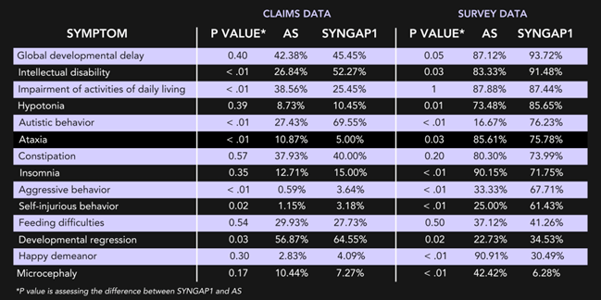Bridging the Gap Between Claims Data and Caregiver Perspectives
In the landscape of childhood development, there are hidden challenges that affect the lives of numerous families. Among these, two rare disorders include Angelman syndrome and SYNGAP1-related developmental and epileptic encephalopathies (DEEs). Among the nearly 500,000 children nationwide grappling with epilepsy, these conditions carve unique, intricate paths of their own. In this article, we will explore these conditions, aiming to illuminate their effects and discern the disparities in how healthcare professionals and caregivers perceive their influence on patient care. To accomplish this, we collaborated with the University of California, San Francisco (UCSF) to create and administer a survey to individuals diagnosed with either Angelman syndrome or SYNGAP1, as well as their caregivers. We subsequently juxtaposed the survey findings with claims data for analysis.
About Angelman Syndrome and SYNGAP1
Angelman syndrome is a rare neuro-genetic disorder resulting from a loss of function in the UBE3A gene and shares symptoms with conditions like autism and cerebral palsy. These similarities can lead to potential misdiagnoses, with recognizable developmental issues appearing around 6 to 12 months of age.
SYNGAP1, on the other hand, is a neurological disorder characterized by moderate to severe intellectual disability that also becomes apparent in early childhood. Its features include delayed speech and motor skills development, hypotonia, developmental regression, recurrent seizures, hyperactivity, and a high likelihood of co-occurring autism spectrum disorder.
Both conditions are characterized by developmental and neurological hurdles that occur within the first year of life and include several overlapping symptoms, however, they are differentiated by the rates at which key symptoms present.
Understanding the Symptomatology of Angelman Syndrome and SYNGAP1
To better understand the symptomology of each condition, we compared claims data to the results of our symptom survey developed in collaboration with our partners at UCSF. The survey was distributed to caregivers with a loved one diagnosed with Angelman syndrome or SYNGAP1. We analyzed the survey responses with medical data from 2017-2022 to identify key differences between symptoms of the two disorders, using a statistical test to determine significance. The claims cohort was made up of individuals aged 21 or younger who had specific diagnosis codes for Angelman syndrome and SYNGAP1, using caregiver-reported diagnoses for the survey sample.
The survey yielded insights from 195 individuals diagnosed with SYNGAP1 and 123 with Angelman syndrome, while claims data identified 216 SYNGAP1 patients and 3,037 with Angelman syndrome. A total of 152 symptoms were recorded, with 14 of the most relevant ones highlighted. Notably, the survey revealed significantly higher symptom frequencies than the claims data for both conditions. Some symptoms, like constipation, were shared between the two disorders but displayed varying frequencies in the two data sources. Additionally, distinct differences in symptom frequency between Angelman syndrome and SYNGAP1 were observed for autistic behavior, developmental regression, and aggressive behavior in both data sets.
Summary of Most Relevant Symptoms

Key Findings
Significant disparities were found between Angelman syndrome and SYNGAP1, as well as between the frequencies reported in survey versus claims data. The higher symptom frequencies seen in survey data likely illustrates a more complete picture of the constellation of symptoms than claims data, which tends to see only a handful of the most active symptoms. The results emphasized that physicians tend to actively report relevant symptoms for treatment and progress, while caregivers often focus on symptoms related to their loved one’s quality of life, emphasizing differences in the perceived burden of illness. This divergence can complicate patient identification using claims data, especially for rare conditions with symptoms that may not be readily included in billing data. Improving the reporting of all symptoms may lead to earlier suspicion and potentially earlier diagnoses of these conditions.
Laney Forton, Ambit’s VP of Patient Identification, stated “Unraveling the contrasting perspectives of healthcare providers and caregivers highlights the intricacies of these conditions. Physicians prioritize clinical terms, while caregivers emphasize life-altering symptoms. This divide underscores the need for comprehensive symptom reporting, which will be a crucial step towards early suspicion and diagnosis in rare conditions.”
Conclusion
In our exploration of Angelman syndrome and SYNGAP1-related DEEs, we’ve uncovered valuable insights into the challenges these rare disorders pose in childhood development. The disparities between claims data and survey responses provide a deeper understanding of symptom frequencies and the nuanced perspectives of caregivers and healthcare providers. These findings emphasize the critical importance of comprehensive symptom reporting. While medical professionals often prioritize terms relevant to treatment and progress, caregivers focus on symptoms that impact their loved ones’ quality of life, which can complicate condition identification, particularly for rare disorders not neatly captured in billing data. Bridging these gaps by enhancing symptom reporting has the potential to facilitate earlier suspicion and diagnosis, bringing us closer to improved support, understanding, and care for individuals and families navigating these unique and complex medical journeys.